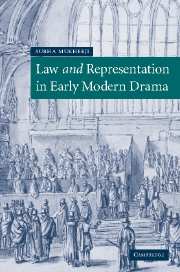Book contents
- Frontmatter
- Contents
- List of illustrations
- List of maps
- Acknowledgements
- Glossary
- A note on the text
- List of abbreviations
- Introduction
- 1 ‘Of rings, and things, and fine array’: marriage law, evidence and uncertainty
- 2 ‘Unmanly indignities’: adultery, evidence and judgement in Heywood's A Woman Killed With Kindness
- 3 Evidence and representation on ‘the theatre of God's judgements’: A Warning for Fair Women
- 4 ‘Painted devils’: image-making and evidence in The White Devil
- 5 Locations of law: spaces, people, play
- 6 ‘When women go to Law, the Devil is full of Business’: women, law and dramatic realism
- Epilogue: The Hydra head, the labyrinth and the waxen nose: discursive metaphors for law
- Appendix
- Bibliography
- Index
3 - Evidence and representation on ‘the theatre of God's judgements’: A Warning for Fair Women
Published online by Cambridge University Press: 18 December 2009
- Frontmatter
- Contents
- List of illustrations
- List of maps
- Acknowledgements
- Glossary
- A note on the text
- List of abbreviations
- Introduction
- 1 ‘Of rings, and things, and fine array’: marriage law, evidence and uncertainty
- 2 ‘Unmanly indignities’: adultery, evidence and judgement in Heywood's A Woman Killed With Kindness
- 3 Evidence and representation on ‘the theatre of God's judgements’: A Warning for Fair Women
- 4 ‘Painted devils’: image-making and evidence in The White Devil
- 5 Locations of law: spaces, people, play
- 6 ‘When women go to Law, the Devil is full of Business’: women, law and dramatic realism
- Epilogue: The Hydra head, the labyrinth and the waxen nose: discursive metaphors for law
- Appendix
- Bibliography
- Index
Summary
Drama, amongst other staged spectacles, was the target of unceasing attack from moralists and reformers from the 1550s. This virulent criticism, strongest in the 1580s and 1590s, was partly an expression of Protestant iconophobia, and partly a Puritan association of the theatre with moral and sexual laxity. Philip Stubbes's An Anatomy of Abuses (1584), one of the most outspoken works in this populous tradition, denounces plays for ‘alluring … People … to Theatres and vnclean assemblies’, ‘Venus pallace, & sathans synagogue’:
Do they not maintaine bawdrie … induce whordom …? … marke the flocking and running to Theatres & curtens … where such wanton gestures … such kissing and bussing, such clipping and culling, Suche winkinge and glancinge of wanton eyes … is vsed, as is wonderfull to behold. Then, these goodlye pageants beinge done … euery one bringes another homeward … and in their secret conclaues (couertly) they play the Sodomits, or worse.
(144–5)His list also specifies the danger of examples ‘painted before your eyes’ by a ‘Cosoners trick’ (146). At the same time, such reformists recognised a need for visual representation and drama's efficacy as a vehicle. A particular kind of drama was allowed, as a concession to flawed, sense-bound human capacities which must be reached through concrete forms. Such images would be
dyvysed to … declare lyvely before the peoples eies the … wickednes of the bisshop of Rome … and to … open to them thobedience that your subiects by goddes and mans lawe owe unto your magestie. Into the commen people thynges sooner enter by the eies, then by the eares … (italics mine)
- Type
- Chapter
- Information
- Law and Representation in Early Modern Drama , pp. 95 - 134Publisher: Cambridge University PressPrint publication year: 2006



